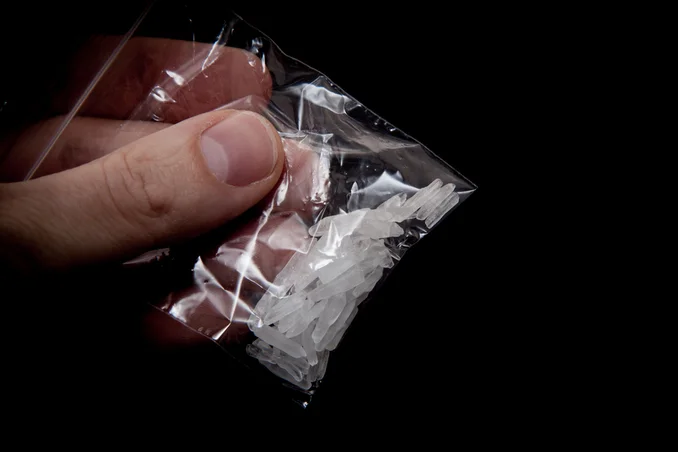Meth and Methamphetamemes
Table of Contents
- Meth and Methamphetamemes
- The Rise of Meth in Popular Culture
- Meth: A New Overdose Crisis in America
- What Is Methamphetamine?
- The Sordid History of Meth and Military Usage
- The Evolution of Methamphetamine in America
- Now, What are Methamphetamemes?
- The Serious Nature of Methamphetamine Addiction
- The Meth Overdose Crisis and Raising Meth Awareness
- Long-term Recovery from Methamphetamine
Rarely has a drug ever existed that presents such a stark contrast between a user’s before and after appearance. The most alarming part is the transformation can take place in a matter of months, in what looks like a difference that would normally take decades.
The substance in question is methamphetamine or crystal meth, and the damage this drug does to users has been widely documented online through a series of memes. These memes, comically titled “methamphetamemes,” put a light-hearted spin on a situation that is no laughing matter in reality.
The Rise of Meth in Popular Culture
Methamphetamemes are a series of photos circulating online via public forums and social media platforms. These photos contain real pictures of methamphetamine abusers arranged in a before and after scenario, highlighting how fast these individuals waste away and virtually transform into former shells of themselves.
The photos also commonly display the amount of time it took for these users to make the transformation, which is often an almost-unbelievably short amount of time. While it’s unknown if the timelines are accurate, normally, the photos are – and they demonstrate the devastating effects this drug can have on individuals who fall into abuse.
Many members of the online communities where these addiction memes are posted, such as Reddit, Facebook, and others, have scoffed at the idea of these memes, calling them cruel, and making light of a situation that often turns tragic. There are two sides to this coin; however, as others comment that these memes are raising awareness of the dark side of substance abuse, they’re a necessary evil.
Meth: A New Overdose Crisis in America
Although it is considered a somewhat controversial topic with a bit of a grey area, one can’t deny the need for increased awareness regarding the severity of methamphetamine addiction. This is especially true now, as the use of this drug skyrockets in an era of monumental overdose deaths and inflated amounts of addiction cases.
However inappropriate it may seem, this side of substance abuse does exist, and the photos (usually) depict real-life situations. Sugarcoating situations like this rarely produce any positive effects. There’s no room to downplay or turn a blind eye to the grim reality of substance abuse disorders like methamphetamine addiction in times like these.
If you haven’t been initiated into the world of methamphetamemes, the first important step is first understanding the specifics surrounding the drug at the center of these photo campaigns. What is methamphetamine, what does meth look like, and how does this drug so rapidly cause such an alarming transformation?
What Is Methamphetamine?
Methamphetamines are a derivative of amphetamines and were developed as an alternative to the ephedra plant. This incredibly powerful stimulant produces intense periods of raised energy, heightened awareness, euphoria, inflated self-confidence, and other side effects. Over time, it also causes life-threatening physical and mental side effects, as demonstrated in the infamous methamphetameme galleries.
Originally, meth was invented in 1893 by a Japanese chemist who synthesized the substance from another similar stimulant.
However, the drug wouldn’t become popular until around 1919, when another chemist developed a more stable and efficient manufacturing method. This new method involved using phosphorous and iodine to crystalize the ephedrine, leading to the first batch of crystal meth.
The Sordid History of Meth and Military Usage
This method eventually spread to Germany, where the pharmaceutical company Temmler produced methamphetamine pills and marketed them to soldiers. These pills were presented as a way to increase endurance and reduce the fatigue caused by long hours of fighting.
Japanese fighter pilots were already regularly consuming these pills, known as Pervitin, in their region, giving them high amounts of energy before suicide missions. Factory workers were also consuming these pills, allowing them to work long hours to manufacture supplies the Japanese military needed to continue their war efforts.
Eventually, Nazi scientists developed pills for the German fighter pilots that contained methamphetamine and cocaine. The pilots were commonly forced to take these pills per command from German leader Adolf Hitler.
The Evolution of Methamphetamine in America
In the United States, the drug Benzedrine was commonly abused throughout the 1950s until 1959, when the FDA began requiring a prescription to purchase the substance. Amphetamines were abused in the United States throughout the 1960s and early 70s, usually in pill form known as Black Beauties and other brand names.
It wasn’t until around the mid-1970s that methamphetamine started gaining popularity in the United States among truckers and biker gangs.
By the time the 1980s rolled around, the federal government had put a ban on the substances required to manufacture methamphetamine, and Mexican drug cartels began providing ephedrine to cooks in large quantities. However, local methamphetamine cooks discovered they could use common household items like acetone, lithium, and paint thinner as the base for their substance of choice.
From Homecooked to Super Meth: Behind the Current Meth Crisis
Through the 1990s, the use of methamphetamine exploded because of an increase in backyard meth labs throughout remote parts of the American West and Midwest regions. However, large DEA campaigns targeting these clandestine labs put an end to the uptick in methamphetamine abuse, and largescale use all but disappeared by the early 2000s.
However, Mexican drug cartels capitalized on the United State’s crackdown on the manufacturing of methamphetamine on American soil and began producing incredibly pure batches in Mexican superlabs.
Presently, batches of methamphetamine seized on the streets of the United States are measuring at over 97% purity, leading to a silent epidemic growing in the shadows of the opioid crisis. There is also growing consideration of new chemical precursors being used to produce meth, known as the P2P meth cooking process, leading to an even more rapid deterioration in long-term meth users.
Now, What are Methamphetamemes?
Methamphetamemes are a series of photos developed by independent internet content creators, highlighting the rapid decay of random methamphetamine users’ physical condition. The photos are crafted as a before and after display, combined with the short amount of time it took for the user to transition to their emaciated state.
Typically, the photos place emphasis on several characteristics – the extreme weight loss, the lack of teeth, a psychotic or delusional demeanor, and the presence of meth sores on the face of the user. The after photos are usually mugshot photos of the users taken during an arrest for methamphetamine possession or distribution.
In some cases, these memes are a series of photos, in sets of three or four, depicting the progression into the final state in different stages. Each photo is labeled with the amount of time it took to achieve the respective state. As stated previously, it is an incredibly short amount of time.
Subsequent variations of methamphetamemes surfaced, making light of the ad campaigns contrived in certain states aimed at methamphetamine awareness. In the following section, we’ll highlight the history of these memes and future variations.
The History of Meth and Memes
The following section highlights the history of the various methamphetameme campaigns.
Faces of Meth
In 2005, Multnomah County, Oregon, began a campaign known as the “Faces of Meth.” This campaign placed before and after photos of individuals arrested for methamphetamine-related charges on billboards and TV screens across the area.
The photos depicted the rapid decline of these individuals, intended to raise awareness of the dangers of methamphetamine use. This campaign was the basis for the original methamphetamemes, spawning hundreds of parody photos and even more real-life transitions.
The Montana Meth Project
In 2008, the state of Montana began an ad campaign intended to highlight the methamphetamine epidemic in the state. The photos, which were meant to be controversial, depicted multiple situations of individuals in compromised positions and performing lude and awkward acts.
Among them was a female engaged in intercourse with what appeared to be a truck driver, with a caption reading “Sex With a Stranger for 15 Dollars? This Isn’t Normal.. On Meth, It Is,” followed by the hashtag “#Meth.NotEvenOnce.” Several more photos of a similar nature were plastered on billboards and played on TV stations across the country.
This gave birth to a new generation of methamphetamemes, although this set strayed away from actual real-life situations of substance abuse. Instead, these were more comical, focusing on other occurrences, often in the sports and entertainment world, where individuals were engaged in odd behavior.
Meth. We’re On It.
Most recently, a 2020 campaign against methamphetamine in the state of South Dakota birthed a new batch of methamphetamemes. The ads portray seemingly normal individuals in everyday settings (an elderly woman in a church, a farmer on his property, high school football players, etc.) while they speak the tagline, “Meth. We’re On It.”
The ads are intended to have a double meaning – depicting the fact that anybody you know could be using meth while simultaneously conveying to South Dakota residents that ordinary people are vigilant and watching for meth activity. Several celebrities and internet personalities made light of the ads, claiming they sent the wrong message to the rest of the country.
Regardless of the reception, content creators wasted no time in creating a new round of methamphetamemes centered around these ads.
While many of these memes are humorous, they don’t erase the serious nature of methamphetamine addiction.
The Serious Nature of Methamphetamine Addiction
The reality of meth addiction is a dark, isolated lifestyle that eventually leads to prison or death. Individuals suffering from meth abuse disorder commonly drop large amounts of weight, develop sores on their faces, and suffer from meth-induced psychosis.
Meth Sores and Meth-Induced Psychosis
Because meth causes individuals to become hyper-focused on whatever activity they happen to be engaging in, results can end up causing severe physical damage. The act of remaining fixated on one activity, known as tweaking, causes users to stay engaged on one single act for hours on end.
It’s not uncommon for users to pick their faces, stand in front of a mirror for long periods, and attempt to remove items from their faces that are usually non-existent. Normally the source of this behavior stems from the belief that there are bugs or objects in the skin.
These delusions, known as meth-induced psychosis, are common among long-term methamphetamine users. Depending on the mindset of the individual, these bouts of psychosis can turn violent, causing the individual to believe that some entity is out to get them or attempting to harm them. Their is still evidence that
Continuing this type of behavior and the overuse of meth can lead to overdose. Currently, there is a huge spike in these occurrences that dwarfs any other period in history.
The Meth Overdose Crisis and Raising Meth Awareness
Currently, there is a crisis of epic proportions that involves large numbers of meth overdoses. It was rare to hear reports of overdose deaths related to meth in the past.
However, overdose deaths have skyrocketed in the last eight years, particularly in Native-American communities. This demographic has experienced overdose death rates nearly four times higher than their average.
These overdose deaths can be linked to three primary causes. The first is the incredibly high potency of the current supply of methamphetamine. Mexican superlabs produce these batches in large quantities. In reality, there’s no need to adulterate the supply with cutting agents because there’s a seemingly infinite supply.
The ingredients are sourced in Mexico, the cooks are members of the cartels, and these groups are able to produce meth with hardly any pushback from authorities.
Second, there’s a marked lack of awareness of the dangers of methamphetamines by the younger generation. The opioid crisis has been front and center, leading to the methamphetamine epidemic being overlooked and all but forgotten about.
The third reason is the lack of an FDA-approved medication to reverse the effects of a methamphetamine overdose. Opioid overdoses can be reversed by administering doses of Narcan to the overdose victims. No such substance exists in similar situations for methamphetamine users.
The biggest hope users have is long-term recovery from methamphetamines.
Long-term Recovery from Methamphetamine
Long-term recovery from methamphetamines is possible with the right team on your side. At Find Addiction Rehabs, we’ve helped countless individuals experience extended periods of recovery from methamphetamine abuse disorder. We know recovery from meth, and we can help.
If you or someone you love is going through challenges related to methamphetamine abuse, contact our recovery representatives today to get started on the road to healing. The time to wait has passed, the time to pick up the phone and get assistance is now!
Eric R. does extensive work in the field of behavioral health as both a professional writer and passionate advocate for those suffering. From his own personal encounters with mental illness, he speaks to those seeking healthy relief from depression and anxiety and embraces wellness both personally and professionally. After losing friends and family to the darkness of suicide, Eric aims to educate and inform about the nature of treatment and render it accessible for all those seeking a way out of darkness and despair.




